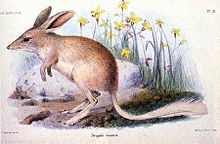Rabbit nosebags
| Rabbit nosebags | ||||||||||||
|---|---|---|---|---|---|---|---|---|---|---|---|---|

Large rabbit nasal sac ( Macrotis lagotis ) |
||||||||||||
| Systematics | ||||||||||||
|
||||||||||||
| Scientific name of the family | ||||||||||||
| Thylacomyidae | ||||||||||||
| Bensley , 1903 | ||||||||||||
| Scientific name of the genus | ||||||||||||
| Macrotis | ||||||||||||
| Reid , 1837 |

The rabbit nasal cones ( Macrotis ) are a genus from the marsupial order of the nasal cones (Peramelemorphia). They are now classified as a separate family Thylacomyidae. The genus includes two species: the large rabbit- nosed bag ( Macrotis lagotis ) and the extinct small rabbit- nose bag ( M. leucura ).
features
Rabbit nosebuyers, like all nosebags, are stocky animals with elongated snouts. They reach a head body length of 20 to 55 centimeters, the tail measures 12 to 29 centimeters. At 0.3 to 0.4 kilograms, the little rabbit-nosed bag was significantly lighter than its larger relative, which weighs up to 2.5 kilograms. The fur of these animals is long, soft and silky, it is gray-brown to blue-gray on the top and white on the underside. The tail has a small, white tassel at the end. The head is characterized by the pointed snout and the large, finely haired ears. The tooth formula is I 4-5 / 3 C 1/1 P 4/4 M 3/3, so they have 46 to 48 teeth in total. The strong front legs are adapted to the digging, they have five toes, the first and the fifth are receding. The three big middle toes are clawed. The hind legs are long and kangaroo-like and are used for hopping locomotion. The first toe of the hind legs is missing, the second and third toes have grown together.
distribution and habitat
Once upon a time, the rabbit-nosed whiskers were found in large parts of Australia and inhabited various habitats such as forests, savannahs, scrublands and deserts. Today they have been displaced into the arid regions and only live in isolated areas in Western Australia , the Northern Territory and Queensland . Successful reintroductions have taken place in the fenced-in sanctuaries of the Australian Wildlife Conservancy , where invasive species such as foxes, cats, goats and rabbits are controlled. These include the Scotia Sanctuary and the Yookamurra Sanctuary .
Way of life
Rabbit whiskers are nocturnal and sleep during the day in self-dug burrows. At night they go in search of food, digging their food out of the ground. They feed mainly on insects and their larvae and other small animals, sometimes they also eat subterranean parts of plants such as roots and tubers.
The gestation period is around 14 days, one of the shortest of all mammals. The young animals spend the first 80 days exclusively in their mother's pouch, afterwards they stay in their den. The known maximum age of a rabbit-nosed bucket was seven years.
Rabbit nosebags and humans
To a small extent, the rabbit-nosed beetles were also endangered before European colonization. Native Australians valued their meat as a treat, and their brush tail was used as an ornament. With the arrival of Europeans, the threats have increased. The populations of both species began to decline dramatically at the beginning of the 20th century. The reasons for this lay in the hunting for their silky fur, in the stalking by introduced red foxes and house cats , in the displacement by the also introduced wild rabbits and in the destruction of their habitat by converting them into pastures or other agricultural areas.
The big rabbit bag has been pushed back into remote, sparsely populated regions and is "endangered" ( vulnerable ) according to the IUCN . Breeding and resettlement programs are ongoing. There are efforts to offer rabbit nosebags made of chocolate ("Easter Bilbies") as a local alternative to the Easter bunny , the proceeds of which are partly used for measures to protect the species. The little rabbit-nosed whisker is extinct. The last sighting was in 1931, in remote regions it could have persisted until the 1960s.
Systematics
In the past, the rabbit nasal cones were classified in the Australian nasal cones (Peramelidae). Recent research has shown that these are more closely related to the New Guinea nasal aspirators than to the rabbit nasal aspirates . That is why they are now run in their own family, Thylacomyidae. ( Thylacomys is an invalid generic name for Macrotis .) They are the sister group of the common taxon from Australian and New Guinea nasal sacs.
literature
- Ronald M. Nowak: Walker's Mammals of the World . Johns Hopkins University Press, 1999 ISBN 0-8018-5789-9
- DE Wilson and DM Reeder: Mammal Species of the World . Johns Hopkins University Press, 2005. ISBN 0-8018-8221-4